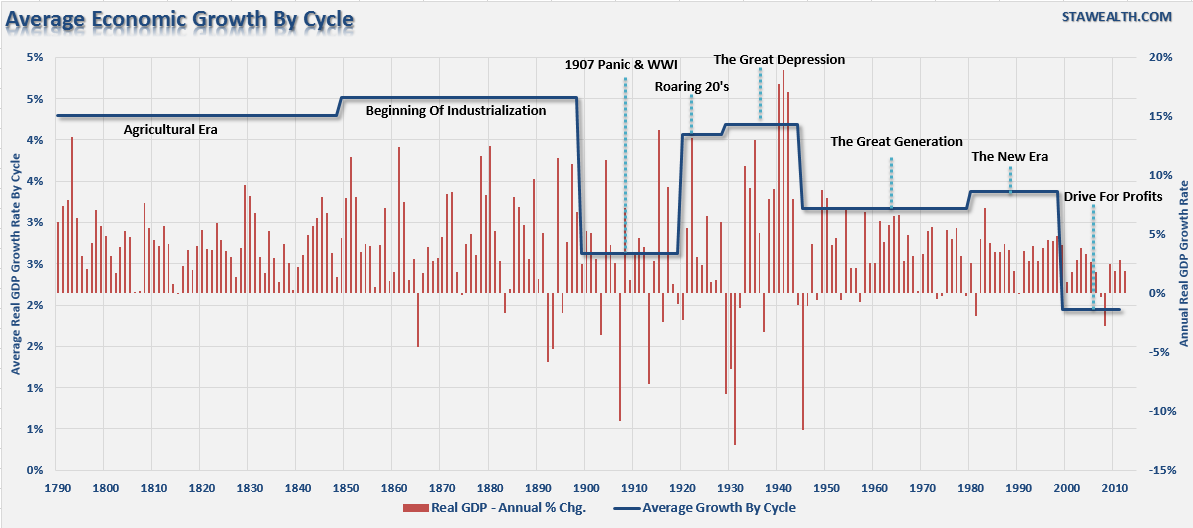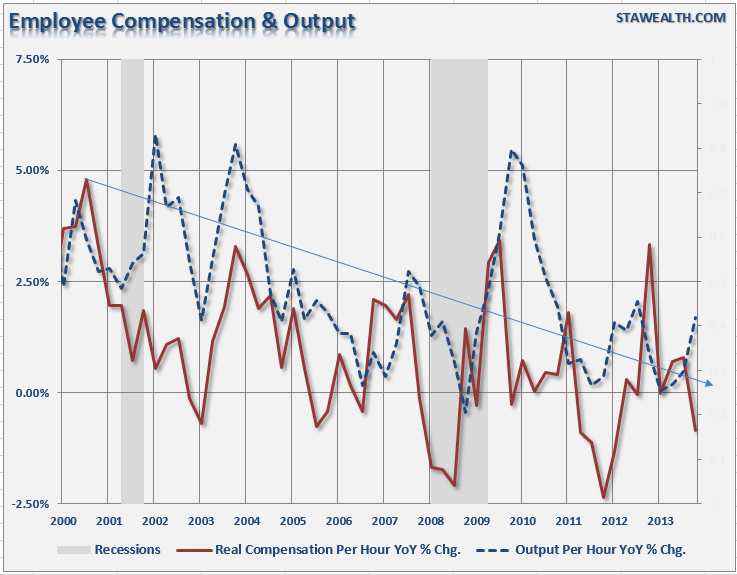Earlier this week I discussed the expectations for an increase in reported earnings of 50% over the next two years:
"Currently, according to the S&P website, reported corporate earnings are expected to grow by 20.26% in 2014, and by an additional 20.28% in 2015. In total, reported earnings are expected to grow by almost 50% ($100.28/share as of 2013 to $147.50/share in 2015) over the next two years."
However, as I also noted, the rise in corporate profitability has come from accounting magic and cost cutting along with a healthy dose of share buybacks. Since there is "no free lunch," the drive for greater corporate profitability has come at an economic expense. Since 1999, the annual real economic growth rate has run at 1.94%, which is the lowest growth rate in history including the "Great Depression." I have broken down economic growth into major cycles for clarity.
As I discussed previously:
"Since 2000, each dollar of gross sales has been increased into more than $1 in operating and reported profits through financial engineering and cost suppression. The next chart shows that the surge in corporate profitability in recent years is a result of a consistent reduction of both employment and wage growth. This has been achieved by increases in productivity, technology and offshoring of labor. However, it is important to note that benefits from such actions are finite."
The latest report on unit labor costs and productivity produced the following two charts which underscore this point and suggests that the current rate of economic growth is unlikely to change anytime soon.
I stated previously, that in in 2013 reported earnings per share for the S&P 500 rose by 15.9% to a record of $100.28 per share. Importantly, roughly 40% of that increase occurring in the 4th quarter alone. The chart of real, inflation adjusted, compensation per hour as compared to output per hour shows a likely reason why this occurred. The sharp increase in output per hour combined with the sharp decline in compensation costs is a direct push to bottom line profitability.
However, it was not just a decrease in compensation costs but in total labor costs as well which includes benefits and other labor related costs. This suggests that the drop off in hiring in the 4th quarter was more than just "weather" related.
Labor costs are one of the largest detractors from net profitability on any income statement. The problem with cost cutting, wage suppression, labor hoarding and stock buybacks, along with a myriad of accounting gimmicks, is that there is a finite limit to their effectiveness.
I say this because of something my friend Cullen Roche recently pointed out:
"We’re in the backstretch of the recovery. We’re now into month 47 of the current economic recovery. The average expansion in the post-war period has lasted 63 months. That means we’re probably in the 6th inning of the current expansion so we’re about to pull our starter and make a call to the bullpen. The odds say we’re closer to the beginning of a recession than the beginning of the expansion. That puts the Fed in a really odd position and not likely one where they’re on the verge of tightening any time soon."
This is a very important point. While the Fed's ongoing interventions since 2009 have provided support to the current economic cycle, they have not "repealed" the business cycle completely. The Fed's actions work to pull forward future consumption to support the current economy. This has boosted corporate profitability at a time when the effectiveness of corporate profitability tools were most effective.
However, such actions leave a void in the future that must be filled by organic economic growth. The problem comes when such growth does not appear. With the economy continuing to "struggle" at an anaemic pace, the effects of cost cutting are becoming less effective.
This is not a "bearish" prediction of an impending economic crash, but rather just a realization that all economic, and earnings, forecasts, are subject to the overall business cycle. What the unit labor costs and productivity report suggest is that economic growth remains very weak. This puts current forward expectations of accelerated economic and earnings growth at risk. With asset prices extended, valuations rich and optimism at extremes, such a combination has historically become a rather toxic brew when exuberant expectations fail to align with reality.



